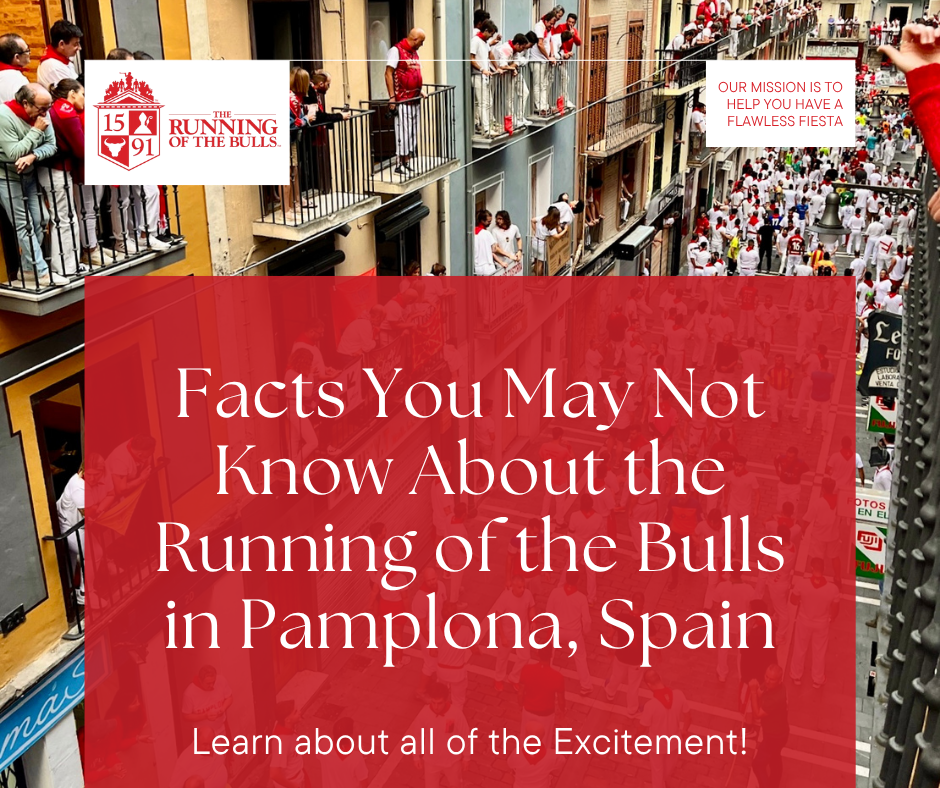Facts You May Not Know About the Running of the Bulls in Pamplona, Spain
One Poster Is Chosen Each Year for the Event
- The yearly San Fermin poster is selected through an annual competition among local artists.
- Artists submit their designs, from which 10 finalists are chosen by a committee.
- A final vote takes place on May 4th each year, with the winner revealed shortly after.
- Because of this competition, each year’s poster is unique, and they are exclusively available in Pamplona during the Fiesta, so don’t forget to grab one to take home!
- San Fermin posters are popular collectors’ items among Fans
- The tradition of the San Fermin a poster dates back to the 19th century.
The Run Is Actually Really Short
- The length of the run is only 875 meters (about half a mile).
- The entire run typically only lasts between 2 and 6 minutes.
The Festival Is Actually a Religious Event to Honor Saint Fermin
- The Fiesta is held to honor Saint Fermin, and his life and sacrifice.
- Saint Fermin was Pamplona’s first saint and its patron bishop.
- It was originally held in September to coincide with Saint Fermin’s Feast Day, the festival was moved to July due to better weather.
- The festival dates back to 1591.
The San Fermin International Fireworks Competition
- Each night during the festival, the San Fermin International Fireworks Competition takes place.
- Peña (social club of Pamplona) attempts to create the best firework show of the festival.
- Fireworks begin at 11:00 PM each night and typically last about 30 minutes.
- The fireworks are launched near Pamplona’s Hotel Ciudadela, so it’s recommended to get a good viewing spot by 10:30 PM.
- The Running of the Bulls also hosts an exclusive VIP event on select nights, featuring dinner and a private fireworks party at the Baluarte Performing Arts Center, where you can watch the fireworks from the rooftop.
The Parade of Giants (Los Gigantes)
- Each morning, the streets of Pamplona come alive with the Parade of Giants, where massive, colorful figures (gigantes) dance through the city.
- There are four sets of giants, each representing one of the continents: Europe, Africa, Asia, and the Americas, highlighting the festival’s universal appeal.
- This parade has been a tradition since the 16th century.
Ernest Hemingway helping build the Festival’s Global Popularity
- The Running of the Bulls became internationally famous, in part, due to its depiction in Ernest Hemingway’s novel, The Sun Also Rises.
- Hemingway visited Pamplona several times during the 1920s and was captivated by the bullfights.
- His first trip to San Fermin was in 1923, and his novel, published in 1926, helped draw a large American audience to the event, many people still visiti today to follow in his footsteps!
The Prized San Fermin Bulls
- The bulls that run during the festival are raised at ranches across Spain, under strict guidelines.
- These bulls are kept in large pastures where they rarely come into contact with humans.
- Each bull requires at least one and a half hectares of land.
- It is considered highly disrespectful to touch any of the bulls during the run.
Butchers Originally Started the Event
- The bull run originated with the butchers of Pamplona, who were responsible for moving bulls through the streets from the ranches to slaughter.
- Butchers began running in front of the bulls to speed up the Bulls, which eventually turned into a competition.
- Over time, locals joined in, leading to the modern-day tradition of the bull runs.
Women Were Once Not Allowed to Run
- On July 1, 1867, a law was passed making the bull runs male-only.
- Women were officially allowed to participate again in 1974, though no women chose to run that year.
- In 1975, Mariví Mendiburu and Alicia Rivas became the first women to take part in the Running of the Bulls.
Ready to experience San Fermin? Customize your itinerary with our Running of the Bulls travel packages. Contact us today!

